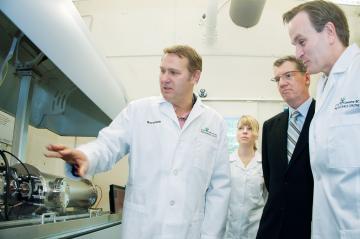New tools, new people set to take UVic research to higher level

Recently announced investment from Western Economic Diversification Canada (WEDC) is contributing to the growth of several UVic initiatives. The welcome financial enhancement will help create fresh knowledge from the bottom of the sea, from within the human body, and from the expertise of new personnel. WEDC coordinates federal economic activities in the West and promotes development of the regional economy by working with communities, industry and the provinces.
Watching body chemistry at work
Thanks to $620,000 provided by WEDC, UVic scientists are closer to being able to answer the complex question of how drugs know where they’re needed in the human body.
New technology on its way to the UVic Genome BC Proteomics Centre will allow researchers to view images—in two dimensions—of drugs travelling within body tissues. They will also be able to see how the tissue reacts to the specified agent and to the environment.
They’ll be able to see all this with the help of an imaging technique known as MALDI—short for Matrix-Assisted Laser Desorption Ionization.
MALDI imaging allows for two-dimensional spatial resolution of proteins and small molecules using a slice of tissue and a fine laser beam. The result is an optical image of the tissue slice that shows the distribution patterns of proteins, peptides, lipids and drugs at the molecular level. It will lead to more rapid and accurate diagnosis of patients’ illnesses and to more effective treatments.
UVic Genome BC Proteomics Centre Director Dr. Christoph Borchers says the information revealed “will be used to develop a 4D virtual reality atlas of the human body and improve a clinician’s ability to diagnose and treat disease. Of particular interest is the diagnosis of specific heart diseases that are currently very challenging to accurately diagnose.”
Diving into deep data, developing ocean tech
Another recent beneficiary of WEDC funding is UVic’s Ocean Technology Laboratory (OTL). With the help of an $800,000 award, UVic’s Laboratory for Automation, Communication and Information Systems Research (LACIR)—of which the OTL is a part—will take delivery of an autonomous underwater vehicle (AUV). Traditionally, underwater work that takes place below depths that are safe for divers has been done by Remotely Operated underwater Vehicles (ROVs): small vehicles that get power and control commands through a tether connected to the surface. In contrast, AUVs operate autonomously, without a tether, minimizing the amount of surface support necessary.
UVic’s new bright yellow Bluefin-12 AUV measures 3.77 metres in length and 0.32 metres in diameter. The vehicle is rated to 200 metres, which will give researchers unlimited access to the depths of Saanich Inlet and beyond. In addition, since it is a well-recognized commercial platform, new instruments that UVic will create for it will have significant commercialization potential.
UVic will take delivery of the custom-built vehicle in March 2010. It will be used in conjunction with the Ocean Technology Test Bed (OTTB) that UVic is constructing in Saanich Inlet, providing valuable ocean-technology research opportunities for students and faculty and increasing the facility’s revenue-generating potential. The OTTB will be fully operational in 2010.
Spreading the wealth of knowledge
It’s not just hardware WEDC is facilitating. Ocean Networks Canada (ONC), the non-profit society UVic created to manage the VENUS and NEPTUNE ocean observatories, has new backing for their work developing commercial applications for ocean science research.
A WEDC investment of $360,000—paired with $240,000 from ONC—will help pay for new Senior Business Development Officer Scott McLean.
The new appointment was announced by ONC President and CEO, Martin Taylor: “We’re delighted to have someone of Scott’s expertise and experience join ONC to lead our new centre of excellence,” says Taylor.
McLean comes to ONC from Halifax, where he worked for eight years as chief technology officer and vice-president of research and development at Satlantic Incorporated, a marine high-tech company.
The funding will help to cover the costs for the ONCEE staff of seven, office set-up, operating costs and equipment.
McLean, who assumed his position as ONCEE director July 1, says he’s excited by the opportunity to promote and support commercialization and outreach for VENUS and NEPTUNE Canada.
“Canada is currently leading the world in this new generation of ocean observing systems and we can build significantly on this competitive advantage.”

